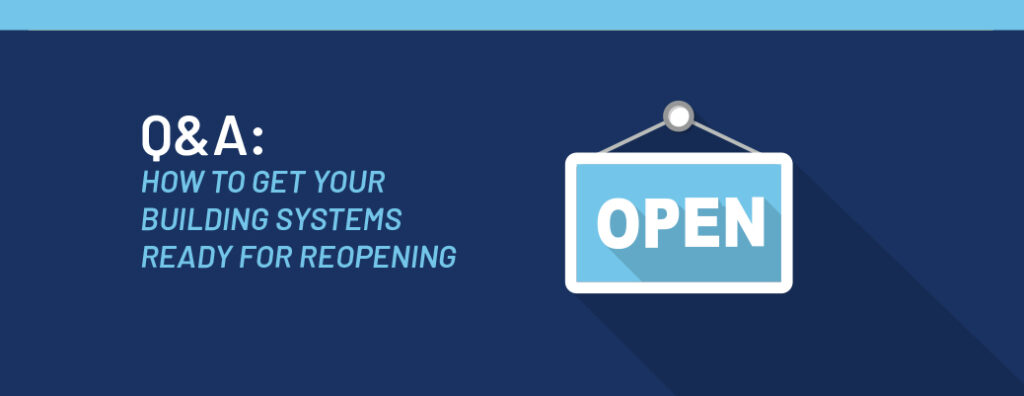
States, counties, and municipalities have recently begun to gradually reopen following the widespread COVID-19 shutdown. A great number of facilities have had their operations scaled back or were shuttered in place. Operations & maintenance (O&M) staff will soon be presented with the challenge of how to plan for – and safely reopen – these facilities. MBP’s Facility Performance team has been consulting with our clients to plan for their facilities to reopen. We wanted to share some questions we received from clients, along with some practical answers when you plan to reopen and occupy your facility.

A good place to start would be to ensure all the facility stakeholders are involved with risk planning. This includes the health, safety, and environment (HSE), facility operations (O&M), and management teams. The HSE team could focus on the risks potentially introduced from the occupants and how they are going to be mitigated, whether through reduced occupancy, continued social distancing, enhanced cleaning, visitor procedures, and any PPE requirements.
The O&M team can focus on the building systems necessary for occupancy:
- Determine if any scheduled or required maintenance was deferred and needs to be completed.
- Review the facility design documentation in connection with any known prior system issues. Key to this review are indoor air quality requirements. According to the EPA, Americans, on average, spend up to 90% of their time indoors, where the concentration of some pollutants are often 2-5 times higher than what is typically seen outdoors.
Management should review and approve the plan, once developed, communicating it to the facility and potential public stakeholders.

Ventilation air and filtration are the two dominant components of indoor air quality. A review of the original design documents for the facility should help. The designers of your facility would have likely used ASHRAE Standard 62 to determine the necessary outdoor air ventilation rates. Equipment manufacturers’ engineering data would have been used, along with other factors, to determine the filtration requirements. One thing to remember when reviewing these documents is the facilities’ current use compared to when it was designed. Space types in buildings often change over its useful life.

Assess the air distribution conditions and environment in the facility:
- Look for disconnected ductwork and blocked diffusers.
- Check for microbial growth, such as mold or mildew, and building envelope issues like water leaks.
- Review and correct any known issues related to odors or staleness that were reported when the building was occupied. Odors may be due to exhaust fans not operating correctly or duct work issues. Staleness could be indicative of improper ventilation or air distribution.
Evaluate the air handling unit coils:
- If dirty, clean the musing by implementing the manufacturers’ recommended cleaning method.
- Replace the filters in mechanical equipment with the designed MERV rated filter or better.
- Check the filter racks to make sure they are not damaged, and air is not bypassing the filters.
- It may be possible to increase the MERV level of filtration, but we would suggest a review by your building commissioning partner to rule out potential degradation of building airflow due to the increased filter efficiency.
Finally, check the operation of the outdoor air dampers:
- Ensure the dampers open and close throughout their entire range.
- Check the Building Management System (BMS) for any operator overrides that may inhibit adequate ventilation. We frequently see operator overrides that affect outdoor air damper operation.

Start the building equipment at least a week ahead of when you expect the building to be occupied. There are a couple of reasons for starting early.
The first is to be able to assess the equipment in an operational condition:
- Make sure temperature and humidity are being controlled properly.
- Make sure the air distribution system is working well.
- If you have not done so, consider enabling temperature and humidity trending of the interior spaces and evaluate them against your chosen setpoints. Occupied space temperature is usually controlled to between 68 and 78 degrees Fahrenheit, and relative humidity for occupied spaces between 40% and 60%.
- Check the outdoor air dampers for proper operation.
- If you have outdoor air flow measuring stations, make sure they are functional and that the air handling unit is controlling to their setpoint.
The second reason for starting early is to adequately flush the building of contaminants prior to the occupants returning. In new construction, using outdoor air prior to building occupancy is used to clear the building of contaminants inherent to the construction process, such as volatile organic compounds from carpet, paint, or adhesives. A similar strategy can be used now. Ventilating the building for a week with the designed outdoor air volume prior to occupancy will eventually displace the stale air currently in the building with fresh air, and in the process, remove some air contaminants.

We are here to help if you need assistance planning or executing your strategy. Our Facility Performance team members have design, construction, operations and maintenance, and building management system experience in a wide variety of buildings. We can assist with all parts of your reopening efforts, including reviewing your design documentation and equipment data for planning, assessing your equipment condition, and verifying your primary IAQ efforts are successful by validating that your ventilation and filtration are operating per the design.
Stay healthy, safe, and comfortable.




